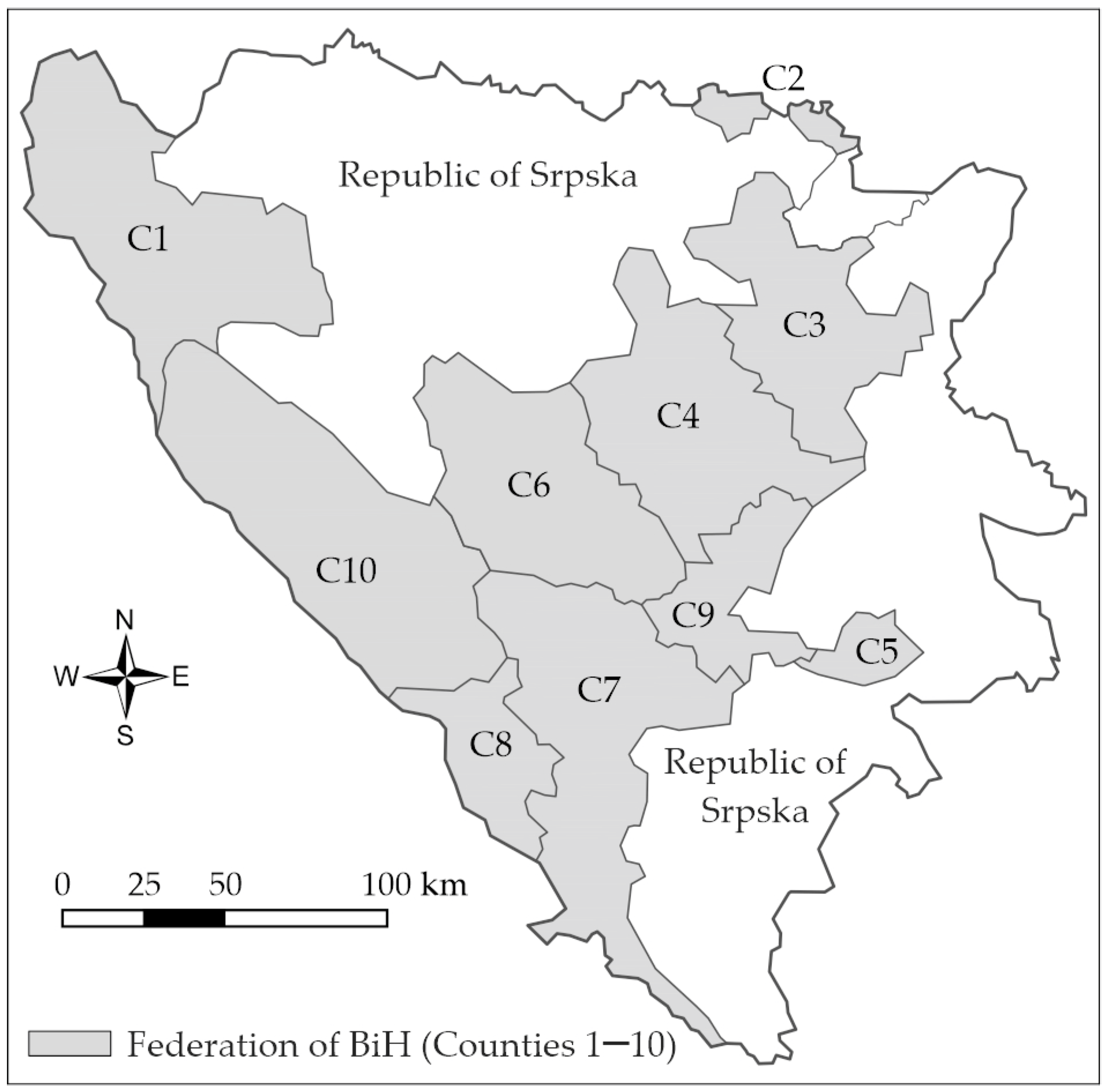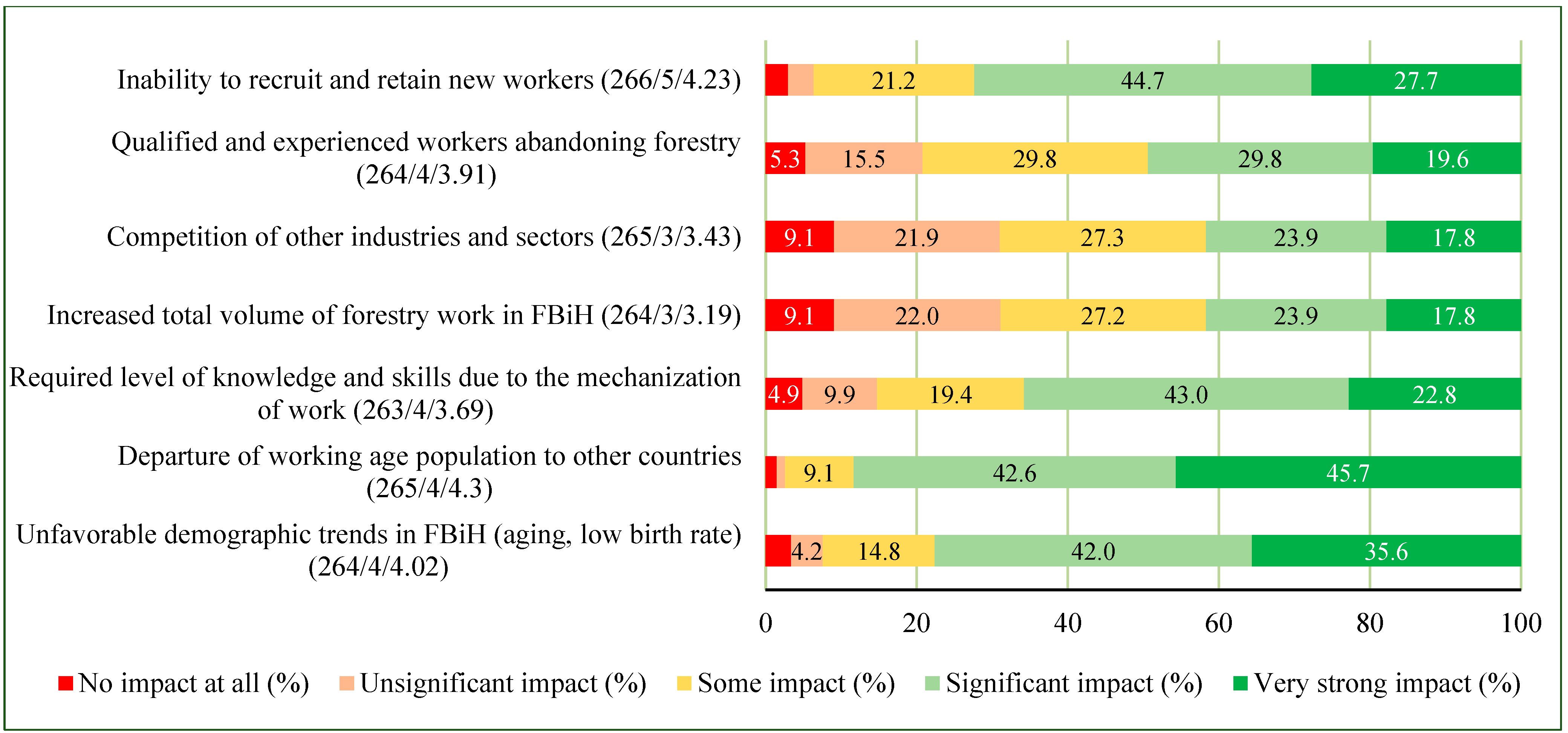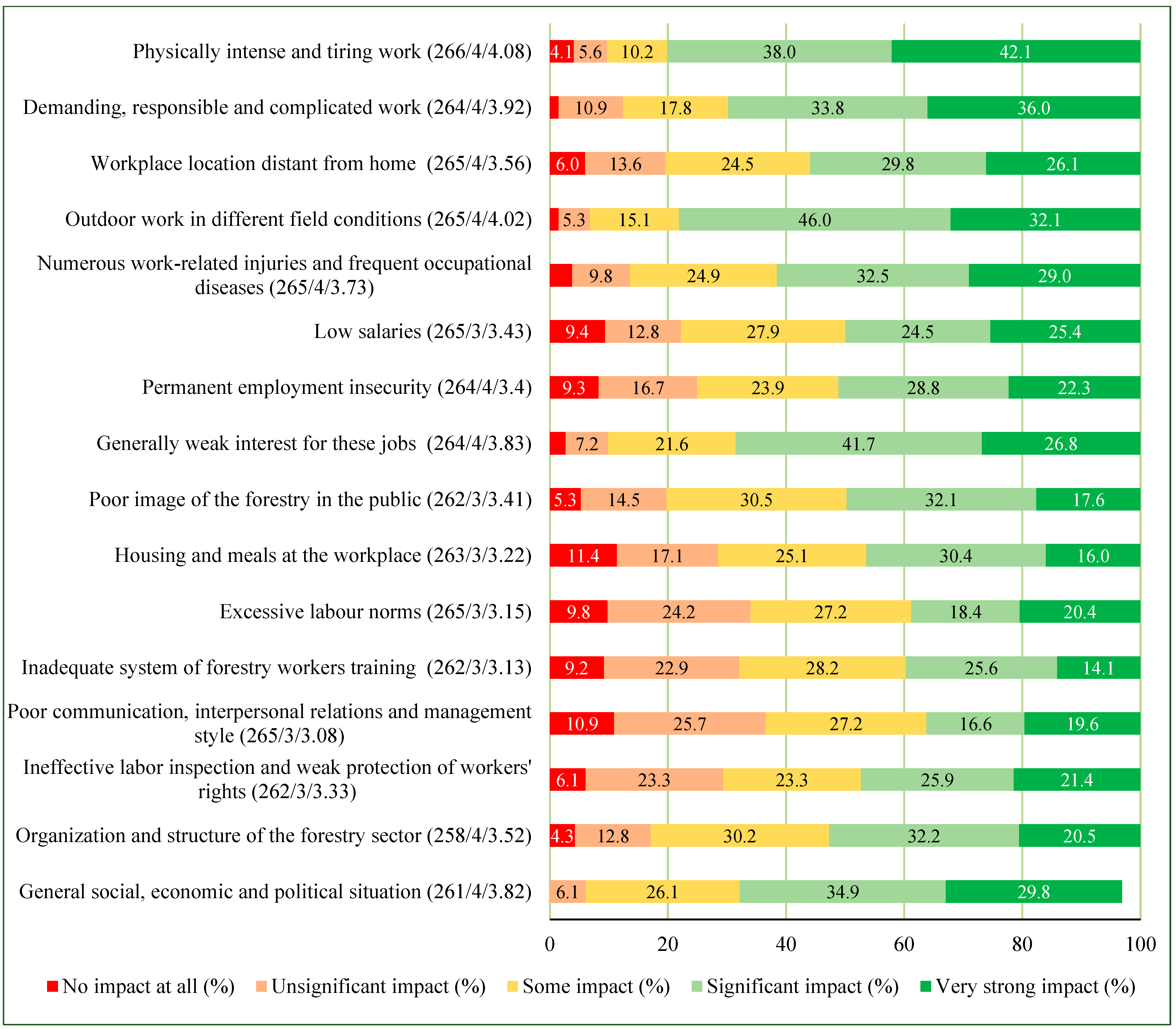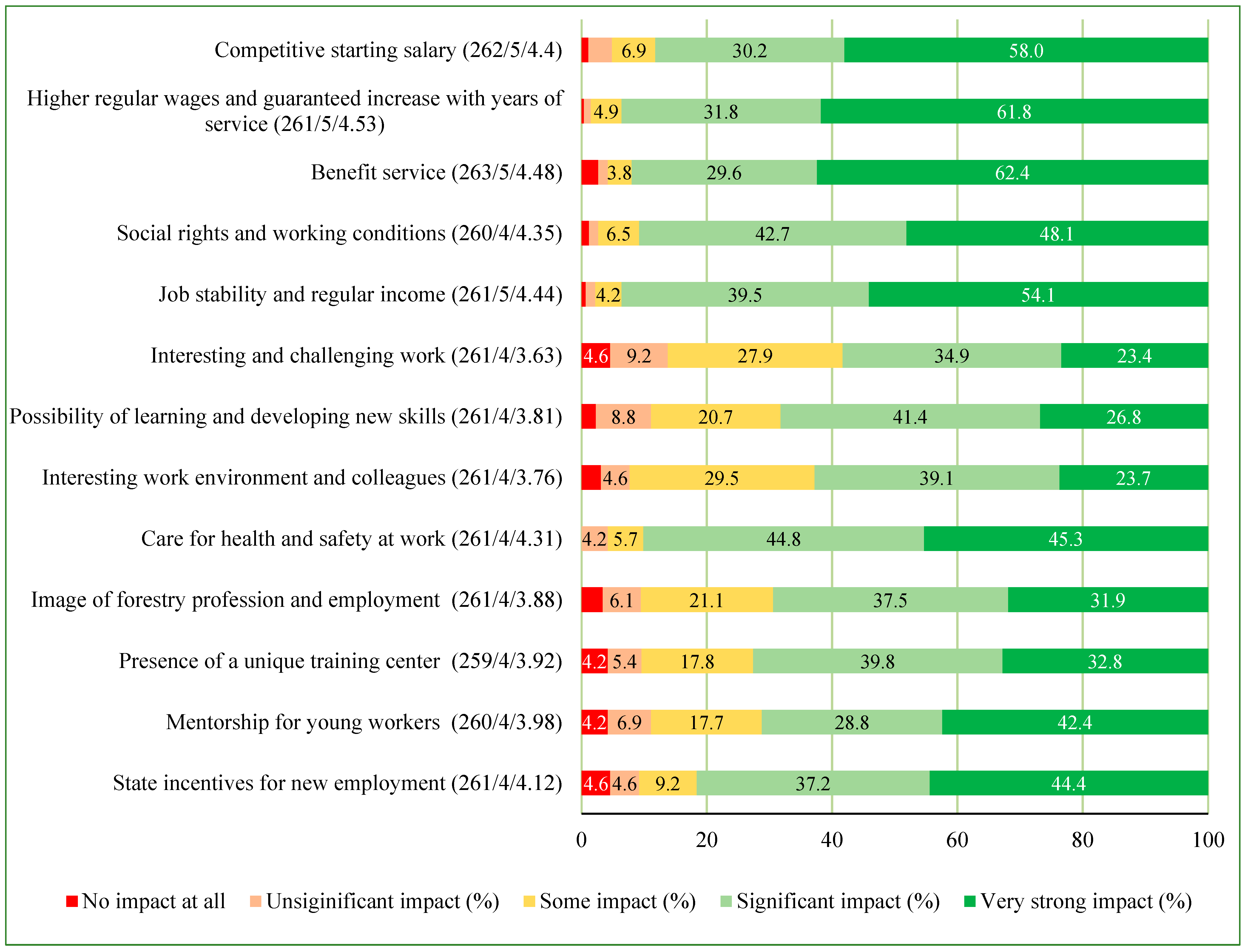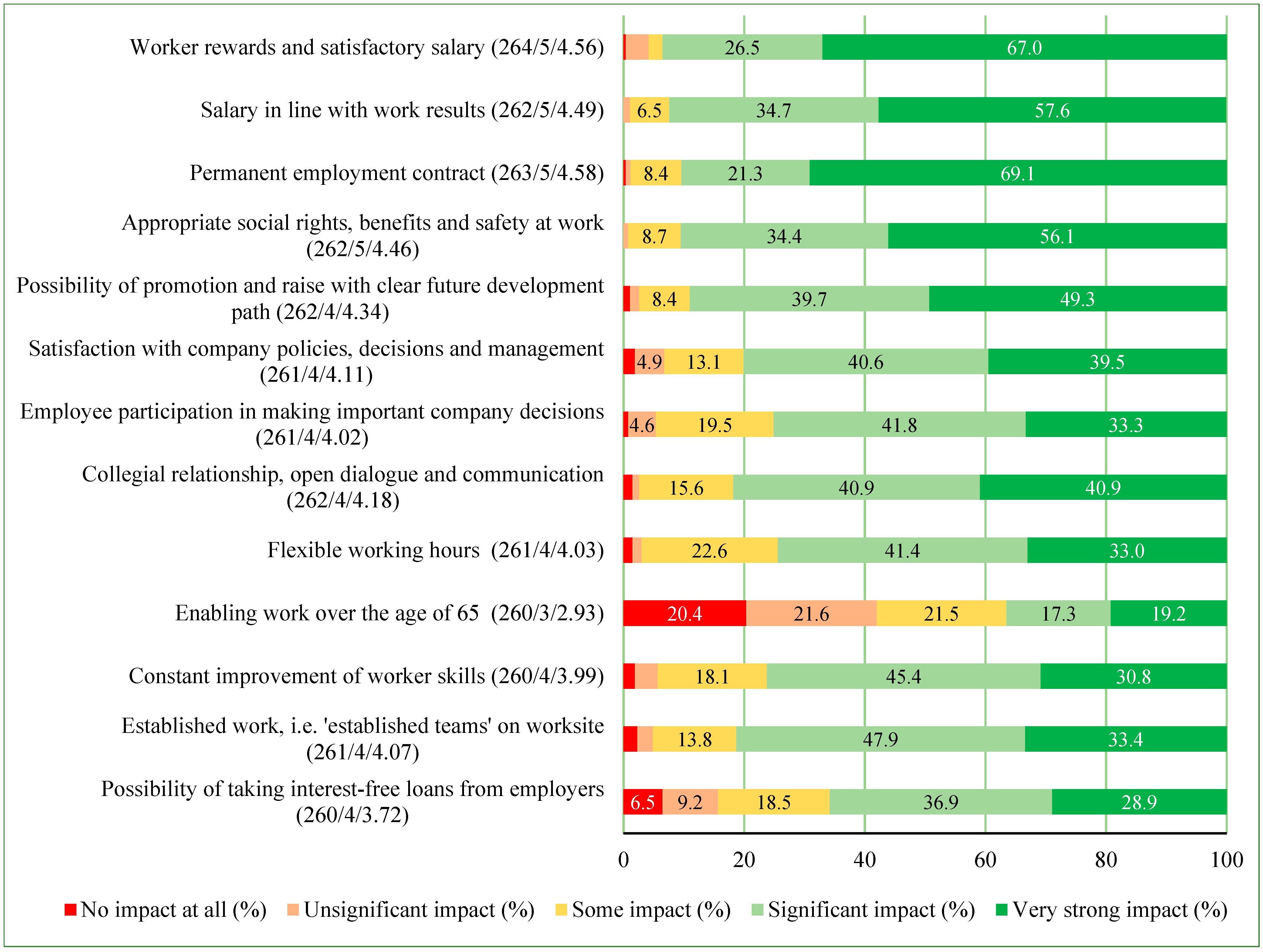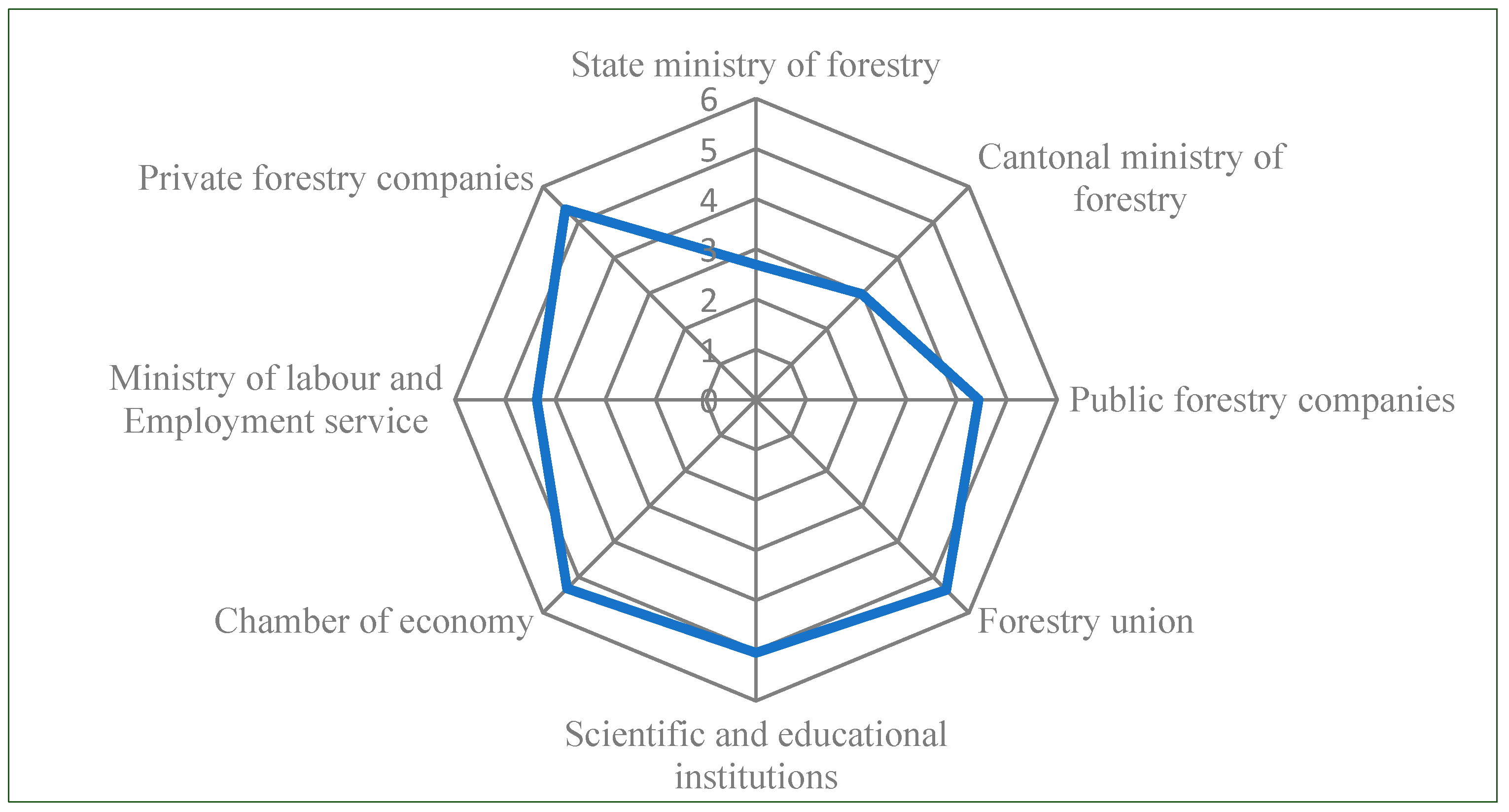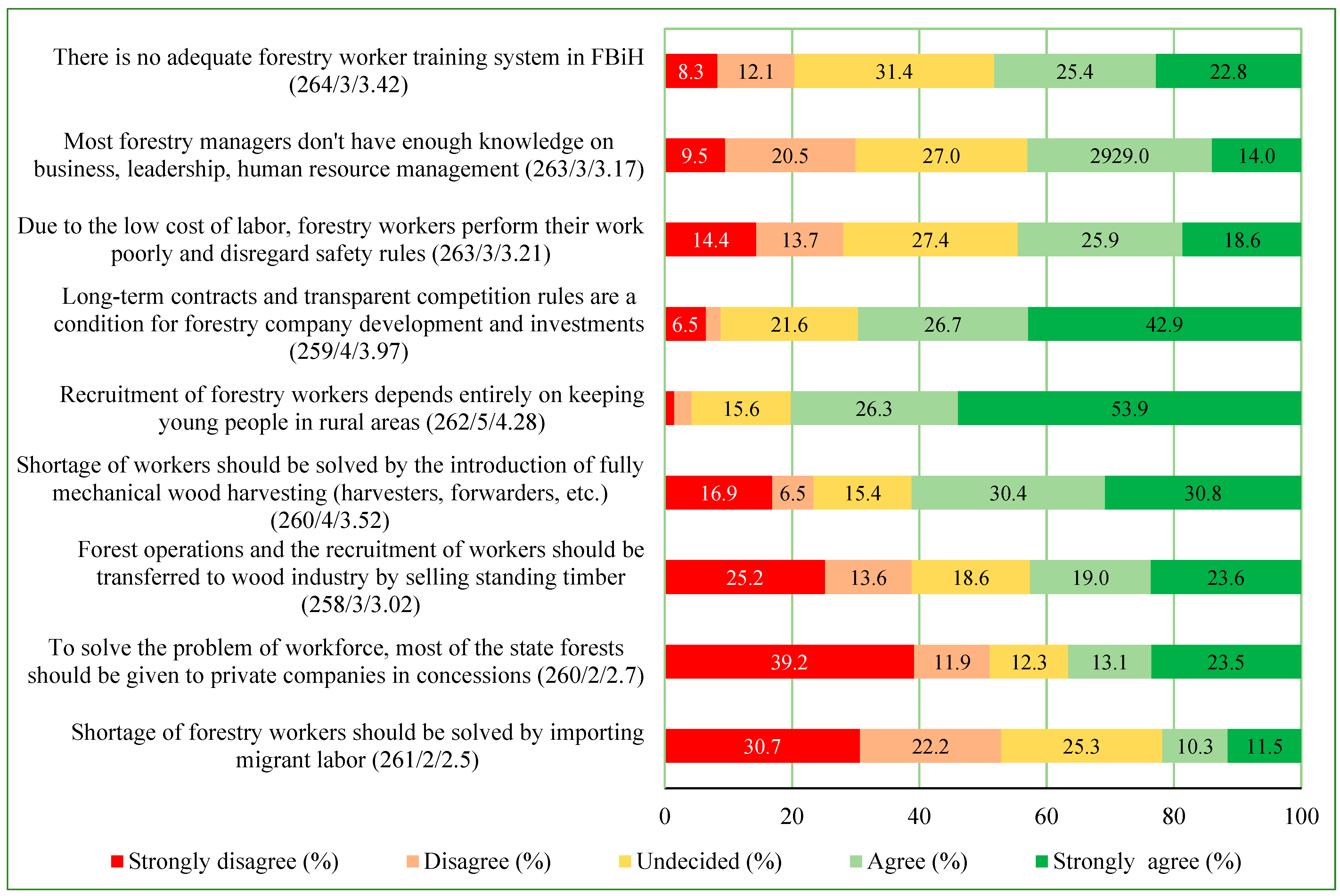1. Introduction
Forestry workers, together with the appropriate means and subject of work, are the main factors of forestry production. Estimates indicate that 13.7 million workers are formally (legally) employed in forestry today, which is 0.4% of the total world workforce [
1]. Professionally trained and motivated workers play an important role in forestry companies’ performance and are a vital part of the modern, generally accepted paradigm of sustainable forest management. Today’s forestry, however, is challenged when it comes to obtaining a qualified and sustainable workforce, and the shortage of forestry workers is becoming a significant problem in European and global forestry, as forestry companies are experiencing increasing trouble in finding and employing necessary forestry workers.
Forest work, especially wood extraction (annual cut in the world is estimated at 3.5 billion m
3 of wood [
2]), is a high-risk, very physically intense and demanding professional activity. Due to working in the natural environment and the frequent use of hand tools and machines, forestry workers are exposed to significant physical, psychological, and environmental factors [
3]. Dangerous working conditions, frequent injuries, and occupational diseases are permanent risks for preserving the working ability and health of workers [
4]. In most countries, forest work ranks among the most dangerous jobs, with a high proportion of serious injuries, deaths, and occupational diseases which are related to the muscular, skeletal, nervous, and cardiovascular systems, as well as hearing impairments [
5,
6,
7,
8,
9]. Accident analyses show that motor–manual felling and processing are the most critical and account for up to 80% of all injuries in the sector [
10,
11]. The total number of injuries in professional forest work in the world is estimated at over 170,000 cases per year [
2]. Additionally, it is believed that working conditions in wood extraction have a negative effect on the mental health of workers [
12]. Seasonal employment, residence in isolated camps, with no continuous supply of electricity or water, and limited access to medical and other services are common in developing countries [
13].
Forestry workers traditionally come from rural areas rich in forests [
14,
15]. However, in the period from 2015 to 2030, in Europe, a much stronger growth of population in cities is expected, and it is predicted that due to the emigration of the rural population, almost a quarter of agricultural land will be abandoned, especially in sparsely populated Mediterranean and mountainous areas that are highly isolated and with difficult living conditions [
16], thus making the pool for recruiting workers even smaller. Other structural changes such as globalization and the aging of the population are also affecting the workforce in forestry. According to UNECE/FAO [
15], the total number of forest workers in Europe decreased by 18% from 2008 to 2016. In the Scandinavian countries and Germany, this is mainly caused by the more significant mechanization of forest work. In Sweden, in a 40-year period, the number of forestry workers went from 100,000 to 10,000, which is a decrease of 90% [
17]. Salminen et al. [
18] state that the number of forestry workers in Finland decreased by 50% in just five years, from 1990 to 1995. In France, in 2004, around 11,000 loggers were recorded, while in 2013 that number fell to 7000, and the decrease did not stop even with the employment of migrant labor [
19]. According to Tsioras [
20,
21], over 85% of forestry experts in Greece believe that the shortage of workers will be a significant problem in the future, due to the continuous decline in their number because of the low interest in forestry jobs and the growing migration of young people to big cities. Bernasconi and Schroff [
22] emphasize the lack of interest among young people in Europe and North America for training and professional development in forest work. In the USA, Egan and Taggart [
23] conclude that almost 70% of New England loggers do not want to recommend this work to their children, even though they themselves came from forestry families. According to He et al. [
24], the forestry sector in the USA is facing a serious structural problem of labor shortages in wood extraction, primarily due to a lack of young workers. In Maine, from 2010 to 2018, the number of forestry workers decreased by 9.4% [
25]. In British Columbia, Canada, the number of forestry workers decreased by 30% from 1994 to 2005 [
26].
This paper shows the reflections of forestry workers in Bosnia and Herzegovina (BiH) on the current challenges and future perspectives on their profession. The findings of the examination include some general features of forestry work and indicators of the state and position of forestry workers in BiH (socio-demographic characteristics, attitudes toward work and their profession, etc.). Certain problems and challenges faced by the forestry sector in obtaining and recruiting the necessary labor force are specially addressed: the severity of the forestry worker shortage, the main causes and reasons for the lack of workers, factors for stronger recruitment and retention of workers, work commitment, sustainability of the workforce, future perspectives on forest work, etc. The differences between workers employed in public and private forestry companies are examined. The purpose of the paper is in sensibilizing the profession and the public to the issues of the workforce in forestry, its position, and reflections, and in providing the basis that can be an important contribution toward improving the condition and sustainability of the forestry workforce.
2. Materials and Methods
Bosnia and Herzegovina (BiH) consists of two entities—the Federation of Bosnia and Herzegovina (FBiH) and the Republika Srpska. The research was conducted in FbiH, which makes up 51% of the total BiH territory. Republika Srpska was not included in the research due to the different management structure of state forests and the great heterogeneity of forestry companies.
FBiH is divided into 10 federal units or counties, and the management of state forests (1,233,808 ha or 82% of the total area of forests and forest lands, i.e., 58% of the total area of FBiH) is entrusted to a separate public forestry company in each county. Only in one county was a forestry company not established due to the very small area of forests and forest lands there (C2). For this reason, the research covered nine out of ten counties (
Figure 1). The annual cut in FBiH amounts to 3.1 million m
3, and semi-mechanized (motor–manual) work prevails in wood extraction, which most often involves felling and wood processing with a chainsaw and hauling with skidders [
27].
In addition to the state forestry companies, a certain number of private forestry companies (contractors) operate in each county. According to the official records, 284 privately owned legal entities were registered in FBiH in 2020, which operate in the field of forestry and logging [
28]. The paper highlights the differences between workers of public (state) and private companies.
The research included forest workers from 9 state and 26 private forestry companies. The sample, i.e., survey coverage, was determined in such a way that 75 questionnaires in printed form were sent to the public forestry companies of each county. The further distribution of questionnaires to public company workers and to private forestry companies was performed by designated forestry managers who expressed a significant interest and willingness to participate in the research. The private companies selected for the research were those that had good and close cooperation with public forestry companies. Designated forestry managers personally handed the questionnaires to forestry workers and collected them.
Prior to the survey and the distribution of questionnaires, working meetings were held in the selected companies with employees interested in the research issue. For this occasion, a short brochure was prepared explaining in a simple way anonymity and the intent of the research, how it was going to be conducted, and what the expected results and benefits of the research were. The reason for this was to raise interest in the research and achieve the best possible responses of respondents and the most credible research results.
The general sample was intended to consist of a total of 675 respondents, which greatly exceeds the required size of a representative sample for a 95% confidence level and ± 5 significance (simple random sample according to De Vaus [
29]), based on publicly available reports on the total number of employees in FBiH forestry (N = 5224) [
30]. The carried-out procedure included the application of a deliberate (quota) sample determined on the basis of personal judgment, with an emphasis on the selection of relevant organizational units (public and private companies) in FBiH forestry. The selection of respondents within them was largely determined by the available forestry workers willing to participate in the research. A pronounced tendency was expressed for the profile of the respondents to represent the existing worker population as well as possible.
The study was approved by the Ethical Committee of the Faculty of Forestry and Wood Technology of Zagreb University (protocol code EP/02-21, 22 September 2021). Before the field survey and data collection, all workers who were sampled received information about the purpose of the research and agreed to participate in the survey.
The distribution and collection of questionnaires were carried out by selected contact persons in forestry companies, i.e., managers with organizational authority who expressed a significant interest in the research. The survey was carried out in the second half of 2021.
The questionnaire was designed on the basis of a literature study, theoretical postulates of human resources management, and recent findings from forestry science and practice. In addition to the introductory part with the necessary instructions and explanations, the questionnaire contained questions on (I) the characteristics of the respondents (sociodemographic data), (II) the attitudes toward the profession and employment in forestry, and (III) the worker shortage and factors of forestry workforce sustainability expressed through elements of recruitment, retention, and the commitment of workers. Written, voluntary, and independent filling of the questionnaire was applied. The language was simple and adequate with the use of additional clarifications and colloquial expressions. A total of 162 questions were formulated, with the largest share of questions in Part III (73%). Closed-ended questions predominated (96%), most often with a 5-point Likert scale used (68% of closed questions). For one fifth of the closed-ended questions, in addition to the offered answers, an additional option was given for an open answer or a free comment. The questionnaire reliability was assessed using Cronbach’s alpha coefficient. Accordingly, the applied questionnaire was considered to be satisfactory as the alpha value was 0.764.
Statistical analysis was carried out using the program Statistica® (TIBCO Software Inc., version 14, Palo Alto, CA, USA). Data processing included descriptive (arithmetic mean, median, standard deviation, etc.) and inferential statistics: parametric tests (t-test, ANOVA) for continuous variables, and non-parametric models (χ2 test, Mann–Whitney U test) for ordinal and nominal variables. Previously, for each variable, an appropriate test of distribution normality and homogeneity of variance was performed (Shapiro–Wilk’s and Levine’s). The results are presented tabularly and graphically.
3. Results
3.1. Response, Structure, and Profile of Respondents
A total of 277 workers (41%) completed the questionnaires. Nine questionnaires were not filled correctly (less than 60% of the questions clearly and properly answered) and were rejected. So, the total number of questionnaires used in the analysis was 268.
General data on workers (age, gender, their residence settlement size, education, workplace, etc.) are shown in
Table 1.
All workers were male, and most of them lived in settlements with up to 500 inhabitants (41%), had completed high school (63%), and worked as loggers (58%). Half of them were employed by a public company, and the other half were employed by a private forestry company. Around 82% of the workers were married and their families had an average of 3.94 members, or 4 members (median). Some 223 respondents (83%) owned their own house or apartment, and 75% rated their living standard as being average, while 24% rated it as being below average. In the workers’ families, an average of 1.47 family members were employed (median = 1), and 73% stated that they did not have any additional income apart from their salary. The majority of workers were permanently employed (73%), while a smaller number had fixed-term employment contracts (27%). Considering certain life (and health) habits, about 60% of respondents stated that they were smokers, 57% occasionally consumed alcohol, and 40% claimed that they never consume alcoholic drinks.
The average age of the respondents was 42.9 years (sd = 9.25), i.e., 43 years (median), with a total length of service of 16.6 years on average (sd = 9.29), i.e., 12.9 years (sd = 8.13) in forestry. More than 60% of them were over 40 years of age, and only 11% were under 30 years (the oldest worker was 63, and the youngest was 22). This represents the demographics of the communities and points to the adverse age structure of forestry workers, as well as the reduced interest of young people in forestry work.
The differences between the groups of respondents showed that the workers in the public companies had an average of 14.8 years of work experience in forestry (N = 130), while for employees in private companies this amounted to 11.2 years (N = 133) (t = 3.70; df = 261; p = 0.0003). The t-test also determined the difference regarding the duration of the last employment. Forestry workers in public companies had been employed by their current employer for an average of 14.2 years (N = 131), while for forestry the workers in the private companies this was averagely 6.7 years (N = 129) (t =8.58; df = 258; p = 0.00000).
A chi-square (χ2) test showed that the number of workers with fixed-term contracts was significantly higher in private companies (37%) than in public companies (17%) (χ2 (1, 268) = 13.725; p = 0.00; fi = −0.23). Since the beginning of their work in forestry, respondents had changed an average of 1.54 employers, and the U-test proved a significant difference between the public and private companies (U = 4320; z = 6.74; p = 0.0000). In public companies, respondents had changed 0.88 employers on average (SD = 1.12, Med = 0, N = 130), while in private companies, this was on average 2.22 (SD = 1.72, Med = 2, N = 129).
According to their labor union activity, respondents indicated membership in a forestry union (41%). A significant difference was found between the public and private companies (χ2 (1, 268) = 144.696; p = 0.00; fi = −0.74). In the private companies, only 7 workers (5%) were union members, while in public companies, 104 workers (78%) were union members.
3.2. Attitudes toward Forestry Work and the Profession of Forestry Workers
The respondents’ viewpoints on the specifics of employment and work in forestry, i.e., the profession of forestry workers, included various issues related to work conditions, the advantages and disadvantages of working in forestry, reasons for choosing this profession, perception and reputation of forestry workers in society, job satisfaction, main job-related concerns and fears, etc.
Table 2 includes the findings on organization, health care, and other work conditions, and the results of testing the differences (Mann–Whitney U test) between the public and private company workers.
Harvesting operations are usually organized in such a way that loggers work in pairs or with an assistant, and tractor operators work with a choke setter. The U-test proved a significant difference between private and public companies, where loggers and tractor drivers in private companies work alone more often. The majority of employers (78.9%) regularly provide prescribed personal protective equipment, with no significant difference between public and private. Workers usually use personal protective equipment, with workers in public companies doing it somewhat more regularly. A similar result was found regarding the prescribed medical examinations. There is an interesting and significant difference in the provision of hot meals—the majority of public company workers receive a monetary allowance instead of a meal (82.1%), while the majority of private company workers receive a hot meal at the workplace (30.8%) or do not receive one at all (21.8%).
As for the main reason for choosing the profession of forestry work, the majority of respondents stated the impossibility of finding another job (41.4%) (
Table 3). This was followed by those who “inherited” the job from their father (28.4%), and there were very few who chose the job because they like and appreciate the work (21.6%) or because they consider the job to be challenging and well paid (8.6%). There were no significant differences between employees in the public and private companies. The main advantage of the job was a good salary (32.6%) and working in the open nature (32.6%), while a slightly smaller share (29.1%) mentioned the challenging nature of the job, which requires skilled workers. Almost half of the respondents (47.7%) stated that hard physical work is the main disadvantage of the job. A significant proportion also stated it being a dangerous job with frequent injuries (21.8%), and a poorly valued and paid job (20.3%). The Mann–Whitney test confirmed a significant difference in the evaluation of the main job disadvantages. The workers in the private companies emphasized more the physical demands and intensity of the work (57.9%), while workers in public companies emphasized the low appreciation of the work and poor wages (31.6%). For the other variables, no statistical differences were found.
Table 4 shows the opinions on the time needed to acquire the necessary skills for safe and independent work in the forest. The majority believed that the training of loggers or tractor operators should last for up to a year (41.7% and 43.1%). A smaller part thought that training requires 1–2 years (36.3%, i.e., 31.7%). Related to this, the vast majority of workers (87.1%) stressed the necessity of establishing a specialized training center for forestry workers.
Table 5 shows workers’ reflections on job satisfaction and the perspectives on work in forestry. The majority stated that they felt satisfied (61.2%), while 17.5% felt indifferent, and 12.7% were dissatisfied or very dissatisfied with their work. There was no significant difference between the public and private companies. About 43.8% of workers experienced insignificant health problems, and 34.3% experienced none. However, more than two thirds of respondents (67.5%) stated that they would never recommend this job to their children. They also believed that society generally perceives their work as being less valuable (42.7%), and very rarely as exciting or interesting (10.9%) or with great respect (6.4%). More than half of the workers (54.2%) thought that their position would not change in the next few years, and as for their main concerns and fears related to work, they highlighted the possibility of injuries (53.0%), the low wages (23.3%), and a fear of job loss (19.5%). The determined statistical differences indicate that the workers in the private companies were more concerned about possible injuries (63.9%), unlike their counterparts from public companies who were more concerned about low wages (34.6%). The high proportion of workers with none or insignificant health issues shows that they have, so far, managed to avoid injuries and preserve their working ability. This speaks of experienced and skilled workers, who are at the same time very aware of the risks and dangers of forestry work, which is reflected in the fact that they cite the possibility of injuries as one of the main concerns related to the work that they perform.
3.3. The Issue of Shortage, Recruitment, and Retention of Forest Workers
More than half of the surveyed workers were convinced that the problem of labor shortage in FBiH exists and tends to get worse (54.5%). About 39.2% believed that this problem has been strongly present for a long time (
Table 6). A very small proportion thought that the problem was not significant or did not exist. No statistically significant difference was found between the workers of public and private companies.
Figure 2 shows the views on the main causes of the forestry labor shortage. A five-point Likert scale was used to assess the impact (1—no impact at all; 5—very strong impact). Next to each evaluated factor, data on the sample size, median, and arithmetic mean are given (in parentheses). The findings indicate that the ‘
departure of working-age population to other countries’ was identified as the main cause of the workforce shortage. This was immediately followed by the
‘inability to recruit and retain new workers’ and ‘
unfavourable demographic trends in FBiH’. Respondents from private companies rated the factor
‘required level of knowledge and skills due to the mechanization of work’ (U = 7291; z = 2.31;
p = 0.0211) as being less important than workers in public companies. No other significant differences were found. Some of the free comments that were recorded regarding the causes of the labor shortage were as follows:
the disappearance of the rural population; lack of interest among young people; mass emigration; no schools for professional training; employment procedures; etc.
Regarding the main reasons for the difficult recruitment and retention of forestry workers, the following were rated as being the most significant:
‘physically intense and tiring work’,
‘outdoor work in different field conditions’,
‘demanding, responsible and complicated work’,
‘generally weak interest for these jobs’, and
‘general social, economic and political situation’ (
Figure 3). The least significant were
‘poor communication, interpersonal relations and management style’,
‘inadequate system of forestry workers training’, and
‘excessive labor norms’. The differences between the groups of respondents showed that the workers from the private companies saw
‘workplace location distant from home’ as being a more significant reason than the workers from the public companies (U = 6968; z = 0.29;
p = 0.0032). On the other hand, the workers in the public companies rated
‘low salaries’ as being a more significant reason compared to the private companies (U = 6752; z = 3.33;
p = 0.0018). Some of the free comments about the reasons for the difficult recruitment and retention were as follows:
the same jobs are better-paid abroad;
outdated regulations from the 70s;
monotonous work; etc.
3.3.1. Workforce Sustainability Factors
Workforce sustainability factors are those elements that contribute to the stability and quality of the labor force, i.e., the optimal balance between the inflow and outflow of qualified forestry workers. There can be many such factors and it is not easy to classify them precisely. In this research, we formed three categories: (1) factors of stronger recruitment, (2) factors of stronger retention, and (3) factors of greater worker commitment. Some of the observed factors were very difficult to clearly and exclusively classify into just one category (e.g., regular salary can be an equally important factor for stronger recruitment as well as the retention of workers), and although some factors were very close, an effort was made to avoid repeating the same factors across several categories.
Factors of stronger recruitment are focused on those elements that can affect the job appeal and attraction of workers, i.e., increase the interest of potential employees.
Figure 4 shows the views on the importance of the factors defined in the survey. The findings show that workers recognize the following factors as being the most important: (1)
higher regular wages and guaranteed increase with years of service, (2)
benefit service, (3)
job stability and regular income, (4)
competitive starting salary, and (5)
social rights and working conditions. The following were rated as being the least significant:
‘interesting and challenging work’,
‘interesting work environment and colleagues’, and
‘possibility of learning and developing new skills’. By testing the differences, it was determined that the workers from the public companies, in contrast to the private companies, attached more importance to the influence of the factors that do not imply direct monetary compensation:
benefit service (U = 7394; z = 2.02;
p = 0.043),
possibility of learning and developing new skills (U = 7263; z = 2.05;
p = 0.0404),
interesting work environment and colleagues (U = 7258; z = 2.06;
p = 0.0395),
image of forestry profession and employment (U = 6471; z = 3.35;
p = 0.0008),
presence of a unique training center (U = 6853; z = 2.54;
p = 0.0112),
mentorship for young workers (U = 6075; z = 3.92;
p = 0.0001), and
state incentives for new employment (U = 7246; z = 2.08;
p = 0.0376). Some of the free comments regarding stronger recruitment were
stipends for requalification,
better prices in forestry,
new machinery, etc.
Factors for stronger retention are aimed at building better working relations between forest workers and employers, with the aim of fulfilling most of their needs and increasing overall job satisfaction. From the presented results (
Figure 5), it is evident that the most important factors were assessed as being (1)
permanent employment contract, (2)
worker rewards and satisfactory salary, (3)
salary in line with work results, (4)
appropriate social rights, benefits, and safety at work, and (5)
possibility of promotion and raise with clear future development path. At the bottom were
‘enabling work over the age of 65’ and
‘possibility of taking interest-free loans from employers’. Differences between respondents showed that the workers from the public companies, compared to the private companies, considered the influence of factors that did not include direct financial compensation to be more important:
permanent employment contract (U = 6906; z = 2.81;
p = 0.0049),
possibility of promotion and raise with clear future development path (U = 7315; z = 2.06;
p = 0.0394),
satisfaction with company policies, decisions, and management (U = 7188; z = 2.17;
p = 0.0297),
collegial relationship, open dialogue and communication (U = 7404; z = 2.55;
p = 0.0108),
flexible working hours (U = 7172; z = 2.20;
p = 0.0277), and
constant improvement in worker skills (U = 7178; z = 2.09;
p = 0.0362). Some of the free comments were
salary in winter period;
legal certainty; and
frequent communication.
Factors of greater worker commitment are oriented toward the better use of human resources in an organization. In a way, they arrange financial and non-financial compensations and constantly build the employee–employer relationship. Almost all of the factors in the research were rated relatively highly and the most prominent were (1)
high level of work organization in the company, (2)
consistent and transparent salary policy criteria, (3)
good cooperation and relationships within the company, (4)
respect received from superiors and colleagues, and (5)
clear job and task description (
Figure 6). Among the less rated elements were
‘possibility of employee education and development’,
‘highlighting the worker merits and encouraging excellence’, and ‘
delegating authority and responsibility for operational tasks’. By examining the differences between the state and private employees, it was determined that the workers in the public companies rated the influence of most of the factors as being slightly more important. Statistically significant differences were found for
possibility of employee education and development (U = 6152; z = 3.79;
p = 0.0002),
highlighting the worker merits and encouraging excellence (U = 6849; z = 2.45;
p =0.0142),
consistent and transparent salary policy criteria (U = 6268; z = 3.51;
p = 0.0005),
clear job and task description (U = 7117; z = 2.10;
p = 0, 0356),
delegating authority and responsibility for operational tasks (U = 6893; z = 2.38;
p = 0.0174),
respect received from superiors and colleagues (U = 7098; z = 2.13;
p = 0.033), and
encouraging and appreciating workers’ deliberations (U = 6759; z = 2.42;
p = 0.0157). Some of the listed free comments were
I work as much as I must and can;
health care;
modernized mechanization; etc.
In assessing the role of individual stakeholders in solving the issue of a worker shortage and strengthening the sustainability of the forestry workforce, respondents estimated that the greatest responsibility should be placed on the State Ministry of Forestry, followed by the Cantonal Ministry of Forestry (
Figure 7). Forestry unions and private forestry companies have the least responsible role, according to respondents.
3.3.2. General Issues of Forest Management
Given that the shortage of a workforce in forestry is a very complex problem, the survey included some general issues of forest management that can directly or indirectly affect the recruitment and retention of workers, i.e., the future perspectives and the sustainability of the forestry workforce.
Figure 8 shows the respondents’ views on the training system, quality and price of work, fully mechanized harvesting, selling standing timber, forest concessions, rural area development, etc.
Respondents expressed the highest agreement with the statement that the ‘recruitment of forestry workers depends entirely on keeping young people in rural areas’ and the statement ‘long-term contracts and transparent competition rules are a condition for forestry company development and investments’. The claim that the ‘shortage of workers should be solved by the introduction of fully mechanical wood harvesting’ was also widely accepted. The lowest level of agreement was determined for the statement that the ‘shortage of forestry workers should be solved by importing migrant labor’. The differences between the groups of respondents showed that the workers in the private companies, in comparison to the public companies, agreed to a greater extent with the following statements: ‘there is no adequate forestry worker training system in FBiH’ (U = 7448; z = 2.10; p = 0.0361), ‘due to the low cost of labor, forestry workers perform their work poorly and disregard safety rules’ (U = 7245; z = 0.33; p = 0.024), and ‘to solve the problem of workforce, most of the state forests should be given to private companies in concessions’ (U = 6467; z = 3.41; p = 0.0014). On the other hand, the public company workers expressed a stronger agreement with the statement ‘recruitment of forestry workers depends entirely on keeping young people in rural areas’ (U = 7086; z = 2.69; p = 0.0073).
4. Discussion and Conclusions
Labor force can be defined as the totality of human physical and mental abilities that can be used to produce use values of any kind. The extent or size of the workforce depends on the total number of inhabitants and their numerous structural characteristics. As an economically active part of the population, it is the most important factor of the production process in all types of societies and industries. It is the same in forestry as in any other production or business system. In forestry, along with other employees, production forestry workers are of special importance and can be considered as the first “link” in the chain of wood harvesting, but also in the realization of all other benefits that are achieved via responsible and multi-functional forest management. A quality and professionally trained workforce is a fundamental prerequisite for forest production and an integral part of modern sustainable forest management standards.
However, today, in a world of constant changes, forestry is increasingly facing the problem of a forestry worker shortage and the challenge of securing a qualified and sustainable workforce. The total number of forestry workers in Europe decreased by 18% in the period from 2008 to 2016 [
15], and in many countries their number is still declining. Such a situation is the result of global structural changes, as well as the specifics of forestry work. These include current demographic trends (population aging, migration, birth rate decline, negative natural increase rate); pronounced lack of interest in the working world for 3D (dangerous, dirty, demeaning) or “black collar” jobs; emigration of the rural population; development of forestry entrepreneurs and the transition of work from the state/public to the private sector [
31]; significant informal employment in forestry [
32] and exploitation of workers [
33,
34]; mechanization of forestry work; high-risk and physically intensive work with numerous injuries and occupational diseases [
5,
6]; shift to multi-purpose forest management; and, more recently, a wider focus on green economy and bioeconomy [
35,
36].
This paper, along with some indicators of the status and position of forestry workers in FBiH, also includes reflections on the future of the profession and the perspectives on forestry work. It was found that most forestry workers chose their job because they could not find other employment; they cited heavy physical work as being the main disadvantage of the job; they thought that the environment and society generally perceive their work as being less valuable; they stated the possibility of injuries and low wages as their main worries and fears; and more than two thirds would never recommend their job to their children. The main causes of the forestry worker shortage are considered to be the following: the departure of the working-age population to other countries, unfavorable demographic trends, and the inability to recruit and retain new workers. The main reasons for the difficult recruitment and retention of workers were identified as physically intense work, outdoor work in different field conditions, demanding and responsible work, generally weak interest for these jobs, and general social, economic, and political situation. As for the most important factors for stronger recruitment and retention, these were considered to be within the realm of financial compensation: higher regular wages and guaranteed increase with years of service, benefit service, job stability and regular income, i.e., permanent employment contract, worker rewards and satisfactory salary, and salary in line with work results. Among the factors of greater commitment to work, the following were highlighted: high level of work organization in the company, consistent and transparent salary policy criteria, and good cooperation and relations within the company. Regarding the general issues of forest management that can affect the future perspectives on forestry work and workforce sustainability, respondents to the greatest extent agreed with the statement that attracting new workers depends entirely on keeping young people in rural areas, while they strongly disagreed with the statement that the worker shortage should be solved by importing migrant labor. Research indicates an unfavorable ratio of the worker inflow and outflow, where existing workers are leaving the sector and forestry companies are struggling with recruiting and employing new workers. So, it appears that the industry is in decline and that it currently fails to provide better conditions for workers, increase interest in forest work, and attract the necessary forestry workforce.
The described situation inexorably leads to an increasingly pronounced decrease in work potential, i.e., lack of human capital in the forestry sector. In this sense, the fear that if certain efforts are not undertaken, the existing workforce in forestry will at some point become overloaded and unsustainable, which may ultimately threaten the sustainability of forest management itself, seems to be justified. The declining forestry workforce requires a proactive approach and the indispensable development and implementation of a strategic approach for strengthening the workforce sustainability. Based on the results of the conducted survey and the workers’ responses, the following four strategic directions may be seen as possible strategies for improving worker recruitment, retention, and work commitment, which strongly affect the sustainability of the forestry workforce:
- (1)
Direct financial strategy: Implies monetary motivation of workers through direct payments and focuses on labor productivity. The main strategic measures are growth of the initial and regular worker salary and its increase with years of service. The strategic direction is focused on productivity, since monetary payments are tied to the achieved work results. Additionally, it is oriented toward enabling advancement in the organization through certain criteria for rewarding and emphasizing the merits of workers, but solely with the aim of increasing direct cash payments.
- (2)
Indirect financial strategy: Focuses on indirect monetary payments and the quality of work, includes increased care for workers, and ensures improved and stable working conditions through permanent employment contracts, regular payments for mandatory and additional health and pension insurance, regular working hours, increased benefit service, adequate accommodation, transport, meals, and equipment, the strengthening of trade unions, and the protection of worker rights.
- (3)
Educational strategy: Directed toward the continuous training and education of workers and their employers, includes increased public awareness about the various aspects and issues of forestry work, and aims at popularizing the forestry worker profession. It enables a constant improvement in knowledge, abilities, and skills, with a special emphasis on increasing the level of health and safety at work. The establishment of a specialized training center for forestry workers is the main infrastructural requirement of this strategy.
- (4)
Technical–technological strategy: Assumes stronger mechanization of forestry work and the introduction of modern, advanced technologies in forest production, which replaces manual and motor–manual work to a greater extent, and consequently reduces the need for forestry workers (loggers, tractor operators, choke setters, auxiliary workers, etc.). In addition, the strategy should focus on the promotion of new (more attractive) jobs, subsidies for replacing the old machinery, the use of modern IT equipment in the organization of work, and the involvement of machine operators in making plans and decisions.
A comprehensive elaboration and comparison of these strategic orientations should additionally include their specific priorities, measures, activities, stakeholders, funding sources, period of implementation, etc.
Improving the sustainability of the workforce in forestry is a crucial but also a very complex issue that includes various fields such as economics, demography, organization, sociology of work, specifics of the sector, etc. Effective human resource management is in numerous sources highlighted as the main factor in the success of modern organizations [
37,
38,
39,
40], and should also gain a much more prominent place in forestry and become the main task of forestry managers. Additionally, the forestry sector should adapt its policies and activities to the global processes affecting the workforce, especially with regard to social, economic, and other trends, through the development of new skills and technologies, the establishment of flexible organizational structures, the reorganization of work, adaptive forms of employment, the introduction of “green jobs”, and other procedures that can contribute to the better sustainability and competitiveness of the sector.
